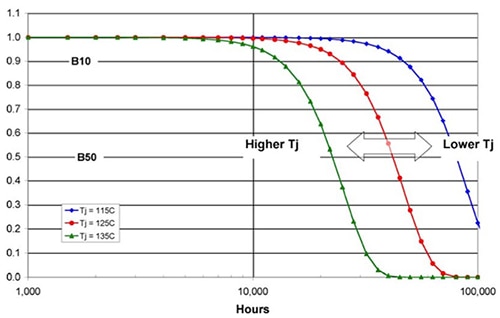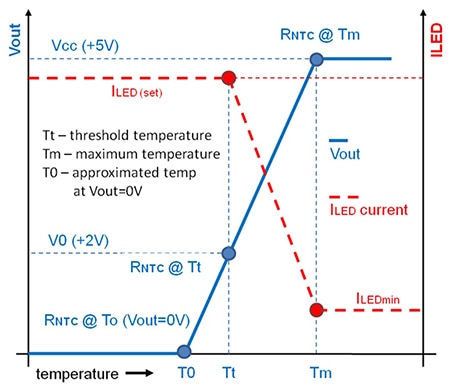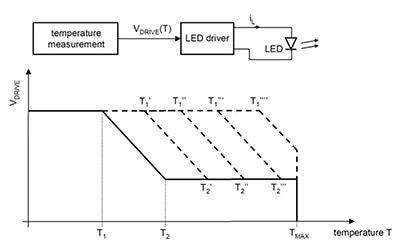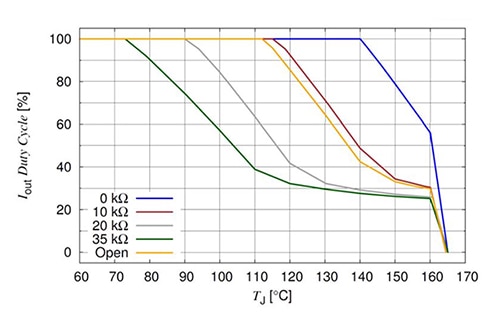Smart Drivers Control LED Temperature to Solve SSL Thermal Issues
投稿人:电子产品
2016-04-06
As high-power LED technology matured, engineers gathered data which quantitatively confirmed how excessive heat shortened the life of solid-state lighting (SSL). For example, an LED that lasted for 60,000 hours while operating at a junction temperature of 120°C struggled to shine for more than 10,000 hours when operating at 150°C. Consequently, thermal management quickly became a key part of the SSL design process.
Designers typically use passive techniques to dissipate heat. During normal operation such methods work well, but can struggle to dissipate all the heat when the SSL is exposed to unusually warm temperatures.
Recently, LED power supply (LED driver) makers have added current-limiting capabilities to their devices allowing engineers to determine LED-junction temperature and turn down the wick if things get too hot. Over-temperature protection extends LED life and minimizes catastrophic failure. Active protection methods also encourage the use of smaller heatsinks––saving cost and space––and offer a greater degree of control over the maximum operating temperature of a particular product. This article takes a look at how these newer thermal-management techniques work.
Killer kelvin
Heat is a byproduct of the electroluminescent processes that enable an LED to light up. Recombinations of holes and electrons in the semiconductor result in some photons exiting the LED and contributing to the overall illumination, but others are reabsorbed in the die, generating heat. Tiny vibrations of the LED’s crystal lattice that occur while the device is operating also raise the temperature. Despite the high efficacy of LEDs compared to conventional light sources, some 70 to 80 percent of the electrical energy applied to the device is still converted to heat rather than light.
Because the LED junction is small, the energy density is high and the temperature rises rapidly. It is not uncommon for the junction temperature (TJ) of modern chips to rise to 140°C and above. Prolonged operation at high temperatures is undesirable because it causes chromaticity drift and shortens life. (See the TechZone articles “Thermal Effects on White LED Chromaticity” and “Understanding the Cause of Fading in High-Brightness LEDs.”)
Manufacturers of LEDs such as Cree, Lumileds, OSRAM, and Seoul Semiconductor provide useful information on the effect of temperature on lifetime, gleaned from years of reliability test data. Figure 1, for example, shows the estimated lifetime of a Lumileds LUXEON C white LED with increasing junction temperature. The left-hand axis represents relative luminosity. LED makers consider an LED to have “failed” when its luminosity falls below 70 percent of the output when new (L70). The LUXEON C is a 118 lm, 120 lm/W (at 350 mA, 2.75 V) LED and it can be seen from the graph that a difference of just 20°C can shorten the life of the LED by around 60,000 hours (from an L70 of 80,000 hrs at TJ = 115°C to 20,000 hrs at TJ = 135°C).1

Figure 1: Effect of junction temperature on luminosity of LUXEON C LEDs. (LED lifetime is measured at the point when luminosity falls to 70 percent of that when new.)
Considering the importance of thermal management when designing with LEDs, it’s little surprise that there’s plenty of design information on the topic available to the design community. Items on LED thermal management in the DigiKey article library include “Understanding LED Internal Thermal Resistance,” “Thermal Considerations for LED-Based Luminaires,” and “ABCs of LED Thermal Management.” Moreover, there are numerous LED thermal products available on the DigiKey website.
Passive thermal-management techniques have played an important role in cementing LED lighting into the mainstream illumination sector. Design engineers routinely specify low-thermal-resistance LEDs and substrates, supplemented with heatsinks, to remove heat from the device junction. However, while this technique works satisfactorily, it does have a number of drawbacks, including increasing the size of a lighting fixture and adding cost. A heatsink can account for a third of the cost of an SSL fixture. In addition, as a passive method, mechanical thermal management is unable to compensate for the large swings in ambient temperature to which, for example, outdoor SSL may be subject.
Active thermal management
More recently, designers have focused on supplementing passive thermal management with active techniques to cater for “extreme” situations where the LED lifetime would otherwise be significantly shortened or the device might even fail catastrophically. The simplest method for protecting the LED is to select an LED driver with over-temperature protection.
Many modern LED drivers incorporate over-temperature protection. For example, Analog Devices’ recently introduced ADP8140 boasts such a feature. The ADP8140 is a linear regulator that operates from a 3 to 30 V input and provides a constant current of up to 500 mA. If the LED driver’s die temperature exceeds 150°C, the ADP8140 shuts down the power stage. When the temperature drops below 130°C, the ADP8140 restarts the power. If the fault or high-power dissipation persists, the sequence repeats. (Note that the ADP8140 can also be used with an external heat sensor to enhance thermal protection.)
The downside of over-temperature protection, which relies on measuring the temperature of the LED driver rather than the LED junction itself, is a lack of precision. Even if the devices are in close proximity it is possible for the LED driver to be several degrees warmer than the LED, which might trigger a shutdown when it is not strictly necessary. Worse yet, the opposite could be true, leading to damage of the LED before the LED driver cuts out. A second disadvantage is that the over-temperature protection of many LED drivers comprises cutting the power altogether when the threshold temperature is reached. That’s hardly convenient, particularly if the light is illuminating a public space. Consequently, engineers tend to set the shutdown function to occur at a very high temperature. While protecting against catastrophic failure this does nothing to extend LED lifetime.
In addition, many LED drivers automatically restart when the system has cooled. If the over-temperature is the result of a fault or an extreme situation such as unusually high ambient temperature, the system is likely to quickly shut down again resulting in a disturbing flicker effect.
A subtler technique than simply switching the LED driver off when a set temperature is reached is to employ a feedback loop that includes a heat sensor positioned very close to the LED junction. By adding a Negative Temperature Coefficient (NTC) thermistor––which typically features a small package size and boasts a good price/performance ratio––into the lighting circuit it’s possible to progressively reduce the current driving the LED and hence decrease power dissipation to limit junction temperature.
Although reducing the current reduces luminosity, designers can set a minimum current such that the change in luminosity as the NTC sensor kicks in is below the threshold that a consumer can detect. Fortunately, the human eye is poor at detecting luminosity changes in high-brightness devices so there is reasonable flexibility in the balance between controlling temperature and noticeably compromising luminosity. In any event, dimming rather than switching off is much more convenient.
LED driver makers have made the incorporation of an NTC resistor into the fixture electronics simpler by adding a dedicated pin to their chips to accept the resistor’s input. Dubbed a thermal foldback circuit, the NTC thermistor is placed as close as possible to the LED’s junction to improve the precision of the temperature measurement. As the temperature increases (above a set value determined by the designer) the thermistor’s resistance decreases triggering a corresponding decrease in the output current that drives the LED. LED-driver manufacturers use either pulse-width modulation (PWM) or analog dimming to lower the output current. (See the TechZone article “How Thermal Foldback Improves the Reliability of LED Lighting Fixtures.”)
LED drivers routinely incorporate current reduction circuitry linked to a heat sensor into their products. ON Semiconductor's CAT4101, for example, is a 1 A constant current, linear LED driver with thermal foldback. The LED driver operates from a 3 to 5.5 V input and offers a 25 V output at up to 1 A. The current is reduced by altering the PWM duty cycle once the LED junction temperature exceeds 150°C. Figure 2 shows how the LED drive current (red) varies with the NTC thermistor’s resistance characteristic (blue).2

Figure 2: Thermal foldback characteristic of ON Semiconductor’s CAT4101 LED driver.
Texas Instruments (TI), among others, also offers a range of LED drivers with thermal foldback. The LM3424, for example, is a step-down/step-up (“buck/boost”) LED driver. The device is able to operate from a 4.5 to 75 V input while providing a constant current up to 5 A. The thermal foldback feature allows the engineer to program both the breakpoint (the temperature at which current reduction commences) and gradient of the current reduction slope.
Improving LED thermal protection
While temperature sensor-based thermal management techniques work reasonably well, there are some drawbacks. First, adding the NTC thermistor increases complexity; and accuracy, response, and gradient depend on how the device is mounted. Second, unless a high-end (and hence expensive) device is specified, the temperature/resistance slope is not linear, making accurate control of current even more difficult. Third, current reduction alone can sometimes be insufficient to limit junction temperature to the safe region forcing the engineer to back up the protection with conventional over-temperature protection.
Because of the drawbacks of NTC thermistor-based thermal foldback technology, some LED-driver manufacturers have taken thermal protection a stage further. Infineon Technologies has implemented a patent-pending technique whereby the LED driver itself becomes the temperature-sensing element, dispensing with the NTC thermistor altogether. The company has implemented the technique in its ILD6070 LED driver IC. The ILD6070 is a buck-voltage converter able to operate from a 4.5 to 60 V input voltage while supplying up to 700 mA. It is supplied in a thermally optimized SOIC-8 package.
The LED driver is tightly thermally coupled to the LED and used as the temperature reference. If the temperature of the LED exceeds a predetermined maximum temperature the current is reduced according to a preprogrammed slope-dimming characteristic. The company claims that this continuous range of adjustment allows the system to reach an equilibrium point that ensures continued operation of the light source under stressful conditions – albeit with reduced light output.
If the thermal equilibrium is upset by additional thermal load the gradual reduction in current continues until a minimum of 25 percent of the target LED average current is reached and the light source will continue to provide light output with a luminosity of 25 percent of the target light output. Such protection allows the engineer to design the passive-thermal management with a lower safety margin secure in the knowledge that the active thermal protection will take over if the temperature rises to an extraordinary level.
The temperature reference of the ILD6070 determines the drive voltage (VDRIVE) in accordance with the slope-dimming characteristic (Figure 3). The drive voltage in turn determines the LED drive current (iL) which is proportional to the luminosity of the LEDs. Dimming is achieved by comparing the VDRIVE signal with an internally generated sawtooth signal which in turn generates a PWM pulse train. (Because it is not always possible to thermally couple the LED driver to the LED, the ILD6070 can be used in a conventional configuration with a NTC thermistor, while still taking advantage of the slope-dimming characteristic.)[3]

Figure 3: Infineon Technologies’ ILD6070 measures LED temperature and sets the drive voltage according to a temperature dependent slope-dimming characteristic.
The designer is able to set the LED junction threshold temperature (which is the point when current limiting commences) by using an external resistor across the ILD6070’s Tadj and GND pins. This has the advantage of allowing the designer to trade off the detrimental effects of high junction temperature against the system cost and size. By setting the threshold temperature relatively low, the LEDs will last longer but the system will require a larger heatsink to ensure heat is dissipated quickly such that the fixture does not repeatedly enter the current-limiting range under normal operating conditions. Figure 4 shows the effect of various resistor values on the ILD6070’s current output duty cycle (and hence its output current).

Figure 4: The trigger point of the ILD6070’s current limiting operation can be altered by selecting a different resistance value.
Over-temperature safety net
Passive thermal management will continue to play a key role in SSL design. Designers should ensure that heat generated by the LED is dissipated through the fixture by employing low thermal resistance LEDs and substrates, and a heatsink of sufficient capacity to radiate heat away to the environment under all anticipated operating conditions.
Where active temperature control comes into play is when unforeseen events such as component failure or very-high ambient temperature occur. Such conditions can thermally stress an LED and dramatically shorten its life. In the worst cases thermal stress can cause catastrophic failure. The use of a temperature-sensor feedback loop which lowers the drive current in the event of excessive LED temperature will eliminate thermal stress and prevent failure. Such a “safety net” allows designers to specify smaller heatsinks with a lower factor of safety––saving cost and space––secure in the knowledge that over-temperature conditions will be catered for by the active temperature control.
Active temperature control continues to evolve with the latest LED driver solutions offering simplified and flexible design solutions by eliminating the external temperature sensor and allowing the designer to select the temperature at which current limiting begins.
For more information about the parts discussed in this article, use the links provided to access product pages on the DigiKey website.
References:
- “Understanding power LED lifetime analysis,” Philips Lumileds technology white paper.
- “Thermal Foldback for CAT4101, LED Lighting,” ON Semiconductor application note, AND9053/D.
- “Intelligent Over Temperature Protection for LED Lighting Applications,” Hakan Yilmazer and Bernd Pflaum, Infineon Technologies white paper, October 2013.
免责声明:各个作者和/或论坛参与者在本网站发表的观点、看法和意见不代表 DigiKey 的观点、看法和意见,也不代表 DigiKey 官方政策。










 中国
中国